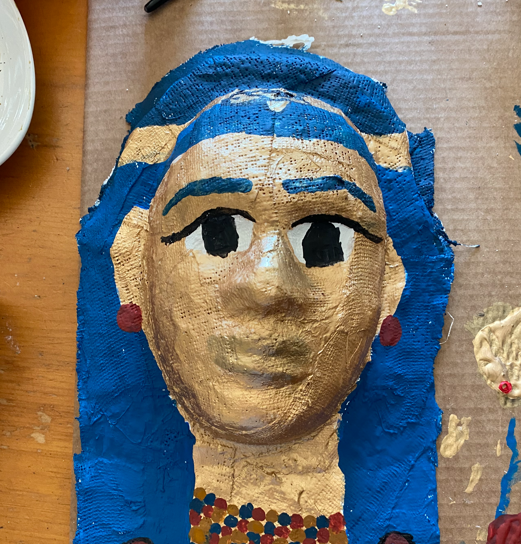History Student Hannah Fuller shares her experience with innovative, cross-disciplinary hands-on research in the History department, including experimental archaeology, visiting museums, building her own virtual exhibition, and publishing her research in Logos: A Journal of Undergraduate Research (Fall 2021). Congratulations to Hannah for her exceptional work!
“I began conducting research for “Gendered Powers of the Dead” in the Spring of 2020 for an artifact corpus project in Dr. Troche’s HST 697: Archaeology and Ancient History. The assignment asked us to choose an artifact type and analyze its material construction and function within ancient Egyptian culture. I selected funerary masks and in the examination of seventeen masks from various museum collections, I became fascinated with how masks acted as a means of memorializing the life of the dead while also attempting to aid their transformation to an idealized self within the afterlife. I specifically took interest in previous research on funerary practice and gender, most notably articles by Christina Riggs and Kathlyn Cooney, and I wanted to more deeply explore conceptions of ancient Egyptian identity and its role in the funerary process. All of these questions led me to continue expanding on the research for a larger project in another of Dr. Troche’s classes, HST 532: History of Ancient Egypt, assessing how funerary masks and coffins utilized gendered expressions of identity as a means of divine transfiguration. This project was then edited and revised and ultimately submitted to LOGOS: A Journal of Undergraduate Research and was accepted to be published in their 14th volume this Fall. I feel very lucky to have had the opportunity to tackle the questions of the project throughout the course of an entire year through several angles. While the article published to LOGOS was the culmination of all the work I completed, I was able to explore these questions within classes through unique methods like attempting to create my own funerary mask (what is known as experimental archaeology), constructing a digital exhibit, and seeing funerary masks in person during a class trip to the Nelson Atkins Museum of Art.
When attempting to study identity within the ancient past, it becomes tempting to place our own modern understandings of gender on history. However, the research I completed for this project strongly suggests the ancient Egyptians conceptualized gender in unique ways and often required a malleable utilization of the feminine and masculine to properly transcend. It seeks to challenge the idea that Egyptian culture mirrored our own patriarchal, heteronormative construction of gender, but rather posits gender as a powerful, divine tool, likely regarded in androgynous, fluid forms. The project also emphasizes the value of material culture within historical research, and advocates for the use of artifacts as a compelling point of primary source analysis in conjunction with texts.
Overall, it has been wonderful to have extensively worked on this project throughout the course of the last year. I hope those who read the article come away with a more nuanced understanding of ancient Egyptian gendered identities and funerary customs and are compelled to continue asking questions that challenge our own frameworks of understanding.”
Link to virtual exhibition: https://www.artsteps.com/view/5fcfa14caf7474125c4fb296

